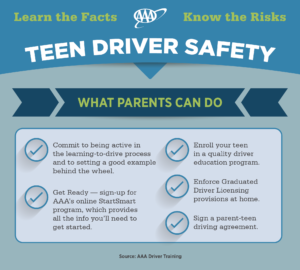 Over the past five years, teen drivers were involved in nearly 14,000 fatal crashes and more than 4,200 of those crashes involved speeding. According to a new AAA survey of driving instructors, speeding is one of the top three mistakes teens make when learning to drive. With 65 percent of those instructors also reporting that parents today are worse at preparing their teens to drive compared to a decade ago, AAA cautions parents that their involvement is key to preventing deadly mistakes behind the wheel.
Over the past five years, teen drivers were involved in nearly 14,000 fatal crashes and more than 4,200 of those crashes involved speeding. According to a new AAA survey of driving instructors, speeding is one of the top three mistakes teens make when learning to drive. With 65 percent of those instructors also reporting that parents today are worse at preparing their teens to drive compared to a decade ago, AAA cautions parents that their involvement is key to preventing deadly mistakes behind the wheel.
“Nearly two-thirds of people injured or killed in a crash involving a teen driver are people other than the teen,” said Bill Van Tassel, AAA’s manager of Driver Training Operations. “Involved parents really can help save lives, so it’s important for parents to coach their teens to slow down, as well as to avoid other common mistakes.”
In the survey, Skills of Novice Teen Drivers, 142 driving instructors revealed the top three mistakes teens make when learning to drive:
Poor Visual Scanning: Driving with tunnel vision and not properly scanning the road for risks or hazards.
Speeding: Traveling over posted speed limits or too fast for road conditions.
Distraction: Interacting with a cell phone, talking with passengers or looking at other objects in the vehicle.
“We all know that the combination of inexperience and risk taking can be a deadly one,” said Jennifer Ryan, director of State Relations for AAA. “Parents need to understand the common mistakes teens are making and take the time to help their teens learn how to stay safer on the road when they are learning to drive.”
In addition to revealing that parents today are worse at preparing their teens to drive than they were 10 years ago, driving instructors report that parents often set a bad example through their own behaviors. A recent survey from the AAA Foundation for Traffic Safety found that drivers aged 35-55 commonly report dangerous behaviors when behind the wheel.
77 percent of drivers aged 35-55 reported talking on a cell phone while driving, compared to 68 percent of teen drivers.
A similar proportion of teens and drivers aged 35-55 reported driving 15 mph over the speed limit on a freeway (45 percent and 46 percent, respectively).
“Parents play a major role in keeping our roads safe,” continued Ryan. “Most teens are learning important driving skills from watching their parents and they are picking up bad behaviors along with the good ones. So it’s up to today’s parents to set a good example. It may end up saving their children’s lives.”
Past research shows that teens with parents who impose stricter driving limits reported fewer crashes and traffic violations. AAA recommends parents stay actively involved in coaching their teens through the learning-to-drive process by:
Having conversations early and regularly about the dangers of speeding and distraction.
Taking the time to practice driving with their teens in varying conditions.
Adopting and enforcing a parent-teen driving agreement that sets family rules for the road.
Leading by example and minimizing distractions and speeding when they are driving.
AAA also recommends that teens preparing for the responsibility of driving should enroll in a driver education program that teaches how to avoid driver distraction and other safety skills. Resources to help parents choose a class and coach their teen through the learning-to drive process can be found on AAA’s award-winning website TeenDriving.AAA.com.
As North America’s largest motoring and leisure travel organization, AAA provides more than 56 million members with travel, insurance, financial and automotive-related services. Since its founding in 1902, the not-for-profit, fully tax-paying AAA has been a leader and advocate for the safety and security of all travelers. AAA clubs can be visited on the Internet at AAA.com. Motorists can map a route, identify gas prices, find discounts, book a hotel and access AAA roadside assistance with the AAA Mobile app for iPhone, iPad and Android. Learn more at AAA.com/mobile.
Search TeenAuto
Socialize with Us
Like us on FacebookFollow us on TwitterWatch our Channel